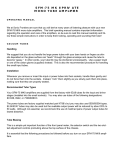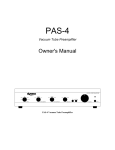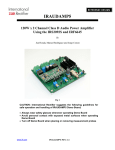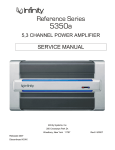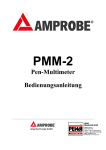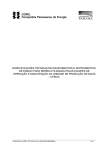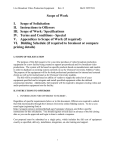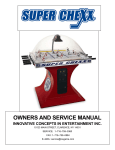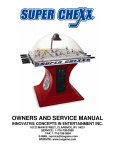Download dunaco Stereo 160 Owner`s manual
Transcript
Stereo 160 Vacuum Tube Amplifier Owner's Manual TRIODE POWER ON ULTRALINEAR POWER OFF R OUTPUT TUBE BIAS ADJUSTMENT ON LEFT CHANNEL V3 V4 RIGHT CHANNEL V7 STEREO 160 Vacuum Tube Power Amplifier V8 BIAS DISPLAY OFF Stereo 160 Vacuum Tube Power Amplifier Contents Introduction ........................................................................ 3 Vacuum Tube Warm Up .................................................... 4 Rear Panel Inputs and Outputs ........................................... 4 Input Sensitivity Setting ..................................................... 5 Power On/Off Indicators and Fuses .................................... 6 Triode/Ultralinear Modes ................................................... 7 Bias Adjustments - general ................................................. 8 Output Tube Bias Adjustment Procedure ........................... 9 Burn-In Procedure for New Output Tubes ......................... 10 Tube Replacement .............................................................. 11 Alternate Tube Types ......................................................... 13 Minimizing Noise in the System ........................................ 14 Warranty ............................................................................. 15 Stereo 160 Specifications ................................................... 16 Schematics .......................................................................... 17 Stereo 160 PC Board Parts List .......................................... 20 Please read this manual thoroughly before operating your new Stereo 160. Introduction Congratulations on your purchase of the Dynaco Stereo 160 Amplifier. This product was designed to provide the highest combination of quality and value available, which is the Dynaco tradition. The Dynaco Stereo 160 amplifier uses special power supply buffering circuitry - found in no other brand of amplifiers in this class. We have included a separate buffer circuit for each of the input and driver tubes in the Stereo 160, allowing each amplification stage to function more independently, (as if each one had its own separate power supply). This method contributes significantly to the sonic clarity of the Stereo 160. The Stereo 160 can be operated in either Triode or Ultralinear mode. between the two is easily done via a front panel switch. Switching State-of-the-art biasing circuitry allows you to easily attain precision bias settings for each of the output tubes through front panel adjustments and indicators. Another special feature of the Stereo 160 is its adjustable Input Sensitivity. This allows the Stereo 160 to be connected directly to components having vastly different output signal levels. The user can, for example, connect a CD player directly to the Stereo 160 without using a preamplifier. You will find the Stereo 160 sounds better than the large majority of other amplifiers both solid state and vacuum tube designs - regardless of price. Your Stereo 160 was designed and built entirely in the USA. We are proud to offer this outstanding amplifier to discerning audiophiles the world over. Dynaco Engineering Group Vacuum Tube Warm-Up Although a vacuum tube power amplifier begins to work in as little as 15 seconds after being switched on, it is important to allow a 3 minute warm-up period before using the amplifier. Output tubes can be slightly damaged each time they are forced into use before being warmed-up, resulting in non-optimum sound and shorter tube life. If one listens to music during the warm-up period, one may notice that the output volume of the amplifier changes as the tubes warm up. We recommend that you wait at least 3 minutes after switching the amplifier on before using it. On the Stereo 160, waiting about one minute after the four bias lamps turn from “green” to “off” is a proper (minimum) warm-up period. (See section entitled Bias Adjustments - general) Rear Panel Inputs and Outputs Inputs There are two input jacks located on the rear panel of the amplifier - labeled Left and Right. These connect to your preamplifier Line Outputs. Never plug in, or disconnect, interconnect cables from other components to the amplifier when it is turned on. To do so could cause a fuse to blow or even damage the speakers. Outputs Match the impedance of your speakers to the amplifier by connecting the positive (+) speaker wire of each channel to its corresponding 2 ohm, 4 ohm, or 8 ohm red binding post. Connect the negative (-) speaker wire from each channel to its corresponding black binding post. You can safely connect or disconnect speaker cables to/from the amplifier while it is turned on. It is best at those times to turn down volume control(s) on any equipment connected to the amplifier inputs. (Nevertheless, care should be taken to not touch bare speaker wires together if one end of the speaker cable is connected to the amplifier.) 4 Input Sensitivity Setting The Input Sensitivity adjustment is located on the rear panel, to the right of the input RCA jacks. This feature allows you to select how large of an input signal will result in full power output of the amplifier. The Input Sensitivity adjustment can be used to “match” the Stereo 160 inputs to your preamplifier outputs. You can set it so that the preamplifier volume control can be turned all the way up before clipping occurs in the Stereo 160. This also allows you to connect audio components, such as CD players, directly to the Stereo 160 without using a preamplifier, if desired. Most power amplifiers have input sensitivities in the range of 1 to 1.5 volts. If an amplifier has an input sensitivity of 1 volt, this means that an input signal level of 1 volt will produce the full rated output power of the amplifier. The Input Sensitivity on the Stereo 160 can be adjusted as follows: Set at Normal (12 o’clock) the input sensitivity is approximately 1.5V. Set at Low (9 o’clock) the input sensitivity is approximately 5.5V. Set at High (3 o’clock) the input sensitivity is approximately .5V. Set fully clockwise, the input sensitivity is under .3V. 5 Power On/Off Indicators and Fuse The Stereo 160 Power On/Off indicator is either the Ultralinear (red) lamp or the Triode (amber) lamp. The lamp which is lit when the Power On/Off switch is turned on will depend upon the Triode/Ultralinear switch position. During the first minute or so after the Stereo 160 is first switched on, all four output tube bias indicator lamps glow green. As the unit warms up, these lamps should go off, indicating the unit is ready for use. If the bias indicator lamps remain green (or turn red) after the initial warm-up period, a low or high AC line voltage condition may be indicated. The AC line voltage varies from country to country, city to city, house to house, and even the time of day in many locations. It can also be affected by common appliances such as electric heaters, microwave ovens, clothes dryers, etc. Therefore, you may need to set the output tube bias adjustments to suit your own location. (See section entitled Bias Adjustments general.) Fuses AC Line Fuse (F1): 10 Amp Fast-Blow - 100 or 120VAC 5 Amp Fast-Blow - 220 or 240VAC 120 To remove the AC line fuse, use a small screwdriver to push forward the tab near the center of the Power Entry Module. PUSH TAB TO RELEASE FUSE HOLDER Output Protection (F2, F3): 1/2 Amp Fast-Blow (regardless of line voltage) F2 (left channel) and F3 (right channel) protect the Output Transformers from damage due to a possible shorted output tube. If either output tube in one channel shorts, the fuse for that channel will blow. Although shorted output tubes should be considered rare, the fuse elements themselves become brittle with age and sometimes fail under normal use. Always keep spare fuses for your Stereo 160 at hand. Always remove the power cord when accessing the AC line fuse. 6 Triode/Ultralinear Modes The Ultralinear mode is usually considered to be the “normal” mode of operation. The overall power rating of the amplifier is specified for Ultralinear mode. In Ultralinear mode, the screen grid of each output tube is connected to a tap on its associated output transformer. When Triode mode is selected, the screen grids are (instead) connected to the plates of their respective output tubes. Operating the amplifier in Triode mode reduces the amplifier output power to about 1/2 of that in Ultralinear mode. Triode mode also softens the clipping characteristics of the amplifier so it seems to need less output power. Triode mode produces more lower-even order harmonics, whereas Ultralinear mode produces higher-odd order harmonics. Some people prefer Triode mode; some people prefer Ultralinear mode. The choice of which mode to use is also often influenced by the sonic characteristics of the speakers being used. You can listen and compare to determine which mode sounds best to you for your chosen music material and speakers. 7 Bias Adjustments - general The Stereo 160 incorporates integrated circuits that monitor the actual quiescent (idle) current of each output tube. For each output tube there is a separate bias adjustment potentiometer accessible from the front panel of the amplifier. Directly above each adjustment potentiometer is the indicator lamp for the tube which it adjusts. The front panel switch labeled Bias Display On/Off must be ON for bias adjustments. The Bias Display On/Off switch (optionally) can be left on while listening to music. If it is left on there will be a “lightshow” display effect which varies with the music material. During bias adjustments each indicator lamp shows three different conditions. When it glows green it means that the bias is set too low for the output tube. When it glows red it means that the bias is set too high. When the lamp is not lit (neither green nor red) it means that the bias setting is correct and is in the range of 87 to 114 millivolts, (measured across each 2 ohm output tube current sensing resistor - R20, 21, 120, or 121). The correct bias current setting for the 6550 output tubes used with the Stereo 160 is: 50ma +/- 5ma Before bias adjustments are made, the amplifier must be fully warmed up. As a minimum requirement, the amplifier should be turned on for 15 minutes prior to bias adjustments. Letting it idle for a full hour so that all components come up to full thermal equalization is also a good idea, but not usually required. Notes: For newly installed output tubes, the first three hours is the “burn-in” period. During this time bias settings need to be closely monitored because they go higher (by themselves) while the tubes burn-in. If a tube is operated with its bias setting a lot higher than it should be, the tube could actually burn out or cause other amplifier components to fail. The output tubes in your new Stereo 160 have already been burned-in and properly biased at the factory. Nevertheless, when you first start using your amplifier you should check the bias settings using the Output Tube Bias Adjustment Procedure on the following page. As mentioned earlier, AC line voltage levels can vary greatly. Even after proper output tube bias adjustments are completed on your amplifier, temporary changes in the AC line voltage can make it seem that the bias settings are not correct. If the AC line voltage is low, one or more of the bias indicator lamps may continue to glow green after the initial one-minute warm-up period. Likewise, if one or more of the bias indicator lamps glows red after the initial warm-up period, a high AC line voltage condition may be indicated. If a low or high AC line voltage condition is only temporary, you do not need to re-adjust the bias settings. 8 Output Tube Bias Adjustment Procedure 1) Warm up amplifier for 15 minutes (or more). 2) Turn off any equipment connected to the amplifier inputs and ensure that the Bias Display On/Off switch is ON. 3) Using the adjustment tool provided with the amplifier, adjust each 25-turn trimmer potentiometer to a point where its lamp does not glow. (This point should be midway between red and green.) Counter-clockwise rotation turns the bias down, “towards green”. Clockwise rotation turns the bias up, “towards red”. Notes: If the lamp is glowing red it means that the bias is set too high. Do not turn the adjustment potentiometer further clockwise as this makes the bias setting even higher. If an output tube bias indicator lamp cannot be adjusted for both green and red, the associated output tube is probably faulty. Adjusting the potentiometer for one lamp can seem to affect the lamps of the other tubes as well. This is normal. Allow each change to settle for a second or two before going on to the next trimmer potentiometer. Repeat the adjustments as necessary. Bias adjustments will be needed less often as the output tubes age. Bias adjustments can be made at any time while using the amplifier - as long as the amplifier is warmed up. If the Bias Display On/Off switch is left on, one can easily check the bias settings at a glance. This could be whenever the amp is not receiving input signals (such as during the blank time between tracks on a CD or record). 9 Burn-In Procedure for New Output Tubes Note: This procedure applies only when you have installed new output tubes which have not yet been burned-in. (The tubes installed on your new Stereo 160 have already been burned-in at the factory.) Also see section entitled: Tube Replacement. 1) Turn off any equipment connected to the amplifier inputs. 2) Turn the bias adjust potentiometer for each newly installed tube fully counter-clockwise. This can take as many as 30 turns. A faint “clicking” sound, which is not harmful, may be heard if you continue to turn the potentiometer beyond its fully counter-clockwise position. (Use the adjustment tool provided with the amplifier.) 3) Switch the amplifier on and allow it to warm up 5 to 10 minutes. Ensure that the Bias Display On/Off switch is set to ON. Note that all bias indicator lamps adjusted in 2) glow green. If any bias adjustment lamp is not glowing green, ensure that its bias adjustment potentiometer is turned fully counter-clockwise. Note: If an output tube indicator lamp cannot be adjusted for both green and red, the associated output tube is probably faulty. 4) Adjust the bias potentiometer for each newly installed tube as follows: a) Turn the potentiometer clockwise to a point where its lamp goes off (glows neither red nor green.) b) Slowly turn the potentiometer counter-clockwise, again, to the point where its lamp just begins to glow fully green again. Repeat this step for each lamp as necessary until all four are glowing green. 5) After 10 minutes check the indicator lamps to see that they are still glowing green. For any lamp not glowing green, slowly turn its potentiometer counter-clockwise only until it glows green again. 6) Check every 30-45 minutes to ensure that the indicator lamps are still glowing green and adjust them if necessary. 7) After three hours, adjust each bias potentiometer to a position where its lamp does not glow (midway between red and green). This completes the burn-in procedure for new output tubes. As future bias adjustments become necessary, use the Output Tube Bias Adjustment Procedure on page 9. 10 Tube Replacement CAUTION: Before replacing tubes on your Stereo 160 ensure the AC power cord is un- plugged from its AC (wall) outlet (or that the AC power cord is unplugged from the back of the unit) and wait for three minutes to allow the high voltage power supply to discharge. Gloves may be worn when changing tubes. Never touch live circuit elements in vacuum tube equipment because lethal voltages are present when these are turned on. Note: There are no user serviceable parts inside the Stereo 160 chassis. If a problem arises other than normal periodic tube replacement, refer to your dealer or a qualified technician. The most common type of problem in tube equipment is excessive noise caused by a worn or faulty tube. The characteristics of this noise can vary a great deal, such as: “excessive hiss,” “sputtering,” “rustling noises,” etc. If a noise problem occurs with your Stereo 160, 99% of the time it will be due to a faulty tube. Vacuum tube equipment owners become familiar with tube noises and usually become less alarmed by them as time goes on. Microphonics (various "pinging" or "howling" sounds) is due to a tube being overly sensitive to physical vibrations. To avoid this, do not operate vacuum tube equipment on top of vibrating surfaces (such as loudspeakers). But, if a tube is so sensitive that just having the amplifier turned on causes the microphonic sounds, the tube will have to be replaced. It can happen that a tube becomes microphonic with age or that it is only microphonic before it warms up (or only after it warms up). Because it is possible for oxidation to build up on vacuum tube pins, it is a good idea to remove and clean them with a small (brass bristle) wire brush once a year. At this time it is also recommended to clean the tube pins with contact cleaner. Contact cleaner leaves a thin coating on the pins which helps prevent oxidation. The contact cleaner can either be sprayed directly onto the tube pins (don’t get any on the glass part of the tube) or can be sprayed on a clean cloth which is then used to wipe the tube pins. Note: When removing a tube, grasp the tube socket with one hand and the tube with the other hand. Move the tube (slightly) from side to side while pulling upward. An easy way to determine if a tube in any particular position is causing undesirable noise is to swap the suspected tube with its counterpart in the opposite channel. If the noise jumps to the other channel, the tube you suspected is indeed faulty. The most certain method for confirming a faulty tube is by substitution of a known good tube. 11 Tube Replacement (cont.) Input and Driver Tubes The input and driver tubes in your Stereo 160 could provide 5,000 to 10,000 hours of use. They will probably outlast the output tubes by a factor of 2:1. We recommend that the input and driver tubes be replaced after no more than 3,000 to 4,000 hours of use to avoid the slightly "muffled" sound or slight bass "roll-off" which can begin to occur with old tubes. This replacement interval is equivalent to about 2 1/2 years when the amplifier is used 4 hours per day (or 5 years when used 2 hours per day). The most likely source of tube noise in the Stereo 160 is the 12AT7 input tube - V1 (left channel) or V5 (right channel). Output Tubes You should expect the 6550s in the Stereo 160 to provide 3,000 to 4,000 hours of use before they have to be replaced. Some audiophiles replace them after as little as 1000 hours of use to keep the amplifier in top form. It is not uncommon, however, for an output tube to become faulty during its normal lifetime. The following conditions indicate possible output tube failure: ➣ An output tube will not bias properly - or refuses to hold its setting. ➣ The amplifier produces a somewhat “muffled” sound during use. ➣ The line fuse blows (other than from normal fuse fatigue). ➣ An output tube glows red during operation. ➣ Arcing is noticed inside the tube, upon close inspection. ➣ A tube filament will not light up. Maximum performance of the Stereo 160 is achieved by using matched pairs of output tubes. The amplifier will work without matched output tube pairs, but may not fully meet all of the performance specifications. Matched pairs of output tubes are available from Dynaco or through your dealer. 12 Alternate Tube Types It is true that vacuum tubes made by different manufactures can actually sound different. The amount and type of sonic differences can be subtle or fairly obvious to a discerning listener. Also, tube reliability and longevity often varies according to manufacturer. Vacuum tube manufacturers are still introducing new versions of older tube designs. These new designs are commonly labeled with partly or wholly new part numbers. Furthermore, different vacuum tube manufacturers often use different part numbers for their own versions of “equivalent” tubes. Distributors sometimes substitute tubes from different manufacturers and/or substitute tubes with alternate part numbers without informing their customers first. Some audiophiles feel strongly about which manufacturer and/or particular version of vacuum tube to use for specific applications. The tubes installed on your new Stereo 80 have been selected to provide the best sound and long life. As of this writing, vacuum tubes are still produced by manufacturers in Germany (Siemens), Russia (Sovtek), Czechoslovakia (Telsa), China (Sino), Yugoslavia (EI), and in England. Your dealer can recommend U.S. tube distributors, if needed. Alternate tube part numbers which can be used on the Stereo 160: Designator Common Part Numbers Alternate Part Numbers V1, V5 12AT7 ECC81 V2, V6 6DJ8 6922, ECC88, 7308 V3, V4, V7, V8 6550 6550A, 6550W, 6550WA, KT-88, KT-90, KT-99 If tube replacement becomes necessary, Dynaco can supply you with new tubes and/or a list of specifically recommended vacuum tubes for the Stereo 160. 13 Minimizing Noise in the System Hum is caused by amplification of the 50 or 60 Hz AC power line signal that is transmitted via the magnetic fields around power transformers and power cables. RF interference usually comes from inadequate shielding of cables or components. If any of these types of noises are encountered, one or more of the following pointers concerning proper component positioning and grounding may be of use: ➣ Ensure that each system component, especially the preamplifier, is located far enough away from the other components so that they will not pick up hum from them, and that the AC power cables are not in close proximity to audio cables. ➣ Ensure that all audio cables are securely pushed into their respective jacks. A faulty audio cable, although rare, can be a source of hum if its outer shield is broken or disconnected from an RCA plug at one end of the cable. ➣ The best system grounding scheme is to have your preamplifier well grounded to an earth ground point and function as the system's main ground reference. Other system components are then quite adequately grounded via their audio cables to the preamplifier’s ground. Using this grounding scheme can be as simple as just plugging the preamplifier’s power cable into a three prong AC outlet. However, if the AC outlet itself does not provide a really "good" ground, the preamplifier power cable can be plugged into a three-to-two prong adapter and a wire can be run from the tab on the adapter to the nearest cold water pipe. ➣ Another solution to AC power cable "ground loop" hum problems is to plug the AC power cables from all of the system components into a common "socket strip" (available from most hardware stores). ➣ If RF noise (usually an AM radio station or CB transmission) is a problem in your area, an AC power filter can be purchased into which some or all of your system power cords can be plugged. This is done if the RF is coming in through the building's AC wiring. However, if RF gets into the system via your turntable, you may have to use tonearm cables with better shielding. (This is tested by unplugging the turntable from the system and putting "shorting plugs" in the preamplifier’s phono inputs before listening again.) RF noise is sometimes eliminated by simply moving the turntable or other components to another location in the room. ➣ Hum from a turntable is usually traced to an adjacent power transformer or a missing or improper ground. Check to see that the turntable motor is grounded via a wire to the preamplifier’s grounding post - (or try removing this wire from the ground post if it is already connected there). 14 Warranty For three years from the date of purchase (one year for tubes) Dynaco will repair, for the original owner, any defect in materials or workmanship that occurs in normal use, without charge for parts or labor. It is the owner's responsibility to provide transportation to the authorized Dynaco service representative who will perform warranty service, and to present proof of purchase in the form of a dated sales slip when requesting service. Excluded from this warranty is damage that results from abuse, misuse, accidents, shipping, or repairs or modification by anyone other than an authorized Dynaco service representative. This warranty is void if the serial number has been removed or defaced. This warranty gives you specific legal rights, and you may also have other rights - which vary from state to state. If service is required, contact the dealer from whom you purchased the amplifier. If that is not possible, write Dynaco, giving us: ✓ Your name and address ✓ Make and model of your amplifier ✓ The amplifier’s serial number ✓ When and where you purchased it (copy of sales slip) ✓ Description of the problem ✓ Whether you have the original carton and fillers or need new ones DYNACO strongly recommends using only its performance checked pretested vacuum tubes. For best amplifier performance, matched pairs of power output tubes are available. Each tube is guaranteed to perform properly in its intended application for ONE YEAR. Orders for tubes may be paid for by personal check or money order. Please also include $4.00 for shipping and handling. 15 Stereo 160 Specifications POWER OUTPUT 75W per channel into 2, 4, or 8 ohms POWER BANDWIDTH: 75W from 14Hz to 65kHz (-3dB points) THD < 1% @ full power @ 1kHz<.05% @ 1W @ 1kHz, matched output tubes FREQUENCY RESPONSE 2Hz to 50kHz (-3dB points) INPUT SENSITIVITY .3V for full power output(Input Sensitivity Control set to maximum) INPUT IMPEDANCE 50k SLEW RATE 30V/µS SIGNAL-TO-NOISE RATIO 90db below full output TUBE COMPLEMENT two 12AT7, two 6DJ8, four 6550 POWER CONSUMPTION: 260 Watts AC LINE VOLTAGE 100V, 120V, 220V, or 240V @ 50/60 Hz DIMENSIONS 17” Wide, 7.75” High, 15” Deep SHIPPING WEIGHT 45 lbs WARRANTY Three years - parts and labor. (one year on tubes) 16 P1A 50K P1B 50K INPUT SENSITIVITY RIGHT INPUT INPUT SENSITIVITY LEFT INPUT R IN L IN V5 1/2 12AT7 R105 301 V5 1/2 12AT7 2 R101 1M 301 R102 2 R1 1M 301 R2 V1 1/2 12AT7 R5 301 V1 1/2 12AT7 3 6 C +475V R104 49 R103 301 1 7 3 R4 49 R3 301 1 7 6 A +475V R8 6.8K C1 220pF 400V 12.7K R7 R108 6.8K C101 220pF 400V 12.7K R106 2K R107 8 R6 2K 8 301 R11 C102 .47uF 400V 301 R111 R109 2M 301 R110 C2 .47uF 400V R9 2M 301 R10 7 V6 6DJ8 2 7 V2 6DJ8 2 R14 30K 5W 6 11K 3W 8 R114 30K 5W 6 11K 3W 8 D 9 R113 3 1 R112 27K 3W +475V D +475V B 9 R13 3 1 R12 27K 3W +475V B +475V 3 R121 2 5W R120 2 5W 3 3 R21 2 5W R20 2 5W 3 8 8 8 8 FB-8 1 4 4 1 FB-5 FB-4 1 4 4 1 Y8 Y7 Y4 Y3 TRIODE FB-7 FB-6 TRIODE TRIODE FB-3 FB-2 TRIODE 3W AND 5W RESISTORS ARE METAL OXIDE 1/2W AND 1W RESISTORS METAL FILM 100pF/400v V8 6550 5 C105B 1K R118 P8 P7 5 330pF/400v R119 2.0K R117 150K 1W R116 150K 1W R115 1K C105A .22uF 630V C104 .22uF 630V C103 V7 6550 330pF/400v V4 6550 5 100pF/400v R18 1K P4 P3 5 C5A R19 2.0K R17 150K 1W R16 150K 1W R15 1K C5B .22uF 630V C4 .22uF 630V C3 V3 6550 FB-1 REV 300, 3W R23 300, 3W 300, 3W R123 300, 3W T3 T2 BLK BRN ORN YEL BLK BRN ORN YEL T3F T3G C 2 ohm 4 ohm 8 ohm RIGHT OUTPUTS T2F T2G C 2 ohm 4 ohm 8 ohm LEFT OUTPUTS P 3 MAR 95 PAGE 1 OF 3 DWG# 00701 STEREO 160 AUDIO SECTION BLU/WHT GRN/WHT RED GRN BLU BLU/WHT +540V ULTRALINEAR K2-B K2-A R122 ULTRALINEAR RED GRN BLU GRN/WHT +540V ULTRALINEAR K1-B K1-A R22 ULTRALINEAR 10A / 100V 10A / 120V 5A / 220V 5A / 240V 8 9 N G L 4 3 6 10 F1 (FAST BLOW) POWER ENTRY MODULE 5 7 C252 C251 THROUGH C254 ARE .01uF, 1.4kV C254 C253 100 R201B OFF ON SW1 C251 AC POWER 100 R201A GRN GRN GRN YEL YEL VIO VIO ORN BLK (GRN/YEL) D8 D7 C214 47uF 160V 2 7 FWB1 V3 2 7 C228 .022uF 250V 2 7 R210 1M 1W R209 264K C229 100uF 35V V4 D11 C217 56uF 400V C216 56uF 400V C218 .68uF 630V 4.7M R211 V7 2 7 V8 C224 4200uF 35V 39 ohm R220 D6 I G O O Q1 C220 .047uF 630V ZD1 12V G IRF 830 G D S C225 470uF 35V S D C221 .047uF 630V 4 S D ZD6 200V 5W ZD5 200V 5W 5 9 5 9 V5 5 4 5 V2 V6 ZD2, 3, 5, 6, 8, 9, 11, 12 = 1N5388B ZD1, 4, 7, 10 = 1N5242B D1 - D11 = 2.5A, 1KV Q1 - Q4 = IRF830 C226 470uF 35V B 4 G ZD4 12V Q2 C210 .68uF 630V +475V V1 R214 470 R207 47K 5w R206 47K 5w A 4 ZD3 200V 5W ZD2 200V 5W C209 820uF 350V C208 820uF 350V +475V R205 47K 5w R204 47K 5w C215 220uF 160V R219 5.2 ohms, 3W R213 470 7812, 7815 I G U2 7815 D9 C219 .68uF 630V 4.7M R212 R208 C207 820uF 350V 3.9K, 3W R203 47K 5w C205 180uF 350V BLU C206 820uF 350V L1 = .24h @ 600mA RED D5 D3 R202 47K 5w D4 D2 C204 180uF 350V XMR GRN SHIELDS BLK/WHT 0.0V BLK 0.0V BRN/WHT WHT 100V 120V BRN 120V T1 120 VAC X 2 (100V TAP) 50/60 Hz RED D1 R215 470 G ZD7 12V Q3 O C +475V ZD9 200V 5W ZD8 200V 5W G U1 7812 R216 470 G ZD10 12V Q4 C227 10uF 250V C223 .047uF 630V C213 10uF 35V S D R218 264K R217 1M, 1W D +475V ZD12 200V 5W ZD11 200V 5W HV OUT - TO T3 HV OUT - TO T2 M2 K2 K1 M1 -85V GND +12V +540V +540V REV P 3 MAR 95 PAGE 2 OF 3 DWG# 00701 STEREO 160 POWER SUPPLY SECTION K2 K1 S D C212 .022F 250V C222 .047uF 630V C211 470uF 35V I F3 .5A (Fast Blow) F2 .5A (Fast Blow) 25K CW 25K CW 25K CW 25K CW 39K R74 39K R73 39K R72 39K R71 6 7 4 5 10 11 8 9 12 1/4 1/4 1/4 1/4 1 2 13 14 V8 BIAS ADJUST V7 BIAS ADJUST V4 BIAS ADJUST R56 1.1K R57 1.1K 1.1K R58 LED2 RED (V4 BIAS) GREEN 1.1K R55 LED1 RED (V3 BIAS) GREEN V3 BIAS ADJUST U3 LM339 3 D10 R75 1K 10K R54 10K R53 M2 (TRIODE) P8 P7 P4 P3 C55 .1uF 160V K2 C52 .047uF 160V C51 .047uF 160V +12V LED5 AMBER 10K R52 10K R51 SW3 ON K1 M1 - 85V P8 P7 P4 P3 Y8 Y7 GND Y4 Y3 +12V OFF BIAS INDICATORS 3 1 2 (ULTRALINEAR) LED6 RED R76 1K C54 .047uF 160V C53 .047F 160V 6 7 4 5 10 11 8 9 TRIODE SW2 1 12 1/4 1/4 1/4 1/4 U4 LM339 3 2 R60 1.1K R61 1.1K (114mV) (87mV) R64 127 R63 13.3K R66 127 R65 17.4K REV P 3 MAR 95 PAGE 3 OF 3 DWG# 00701 STEREO 160 BIAS ADJUST & INDICATORS (MOUNTED TO FRONT PANEL) BIAS ADJUST PC BOARD 1.1K R62 LED4 RED (V8 BIAS) GREEN R59 1.1K LED3 RED (V7 BIAS) GREEN ULTRALINEAR 3 1 2 13 14 Stereo 80 PC Board Parts List Resistors 39 ohm, 1/2W, metal film 49 ohm, 1/2W, metal film 100 ohm, 1/2W, metal film 127 ohm, 1/2W, metal film 301 ohm, 1/2W, metal film 470 ohm, 1/2W, metal film 1K, 1/2W, metal film 1.1K, 1/2W, metal film 2K, 1/2W, metal film 6.8K, 1/2W, metal film 10K, 1/2W, metal film 12.7K, 1/2W, metal film 13.3K, 1/2W, metal film 17.4K, 1/2W, metal film 39K, 1/2W, metal film 264K, 1/2W, metal film 1Meg, 1/2W, metal film 2 Meg, 1/2W, metal film 4.7Meg, 1/2W, metal film 150K, 1W, metal film 1 Meg, 1W, metal film 5.2 ohm, 3W, metal oxide 300 ohm, 3W, metal oxide 3.9K, 3W, metal oxide 11K, 3W, metal oxide 27K, 3W, metal oxide 30K, 3W, metal oxide 2 ohm, 5W, metal oxide 47K, 5W, metal oxide Dual Potentiometer - 50K audio taper Trimmer Potentiometer - 25K R220 R4, 104 R201A, 201B R64, 66 R2, 3, 5, 10, 11, 102, 103, 105, 110, 111 R213, 214, 215, 216 R15, 18, 75, 76, 115, 118 R55, 56, 57, 58, 59, 60, 61, 62 R6, R19, 106, 119 R8, 108 R51, 52, 53, 54 R7, 107 R63 R65 R71, 72, 73, 74 R209, 218 R1, 101 R9, 109 R211, 212 R16, 17, 116, 117 R210, 217 R219 R22, 23, 122, 123 R208 R13, 113 R12, 112 R14, 114 R20, 21, 120, 121 R202, 203, 204, 205, 206, 207 P1 P3, 4, 7, 8 Capacitors .01uF, 1.4kV, ceramic disk 100pF, 400V, polypropylene, 5% 220pF, 400V, polypropylene, 5% 330pF, 400V, polypropylene, 5% .022uF, 250V, polypropylene, 10% .047uF, 160V, polypropylene, 10% .047uF, 630V, polypropylene, 10% .1uF, 160V, polypropylene, 10% .22uF, 630V, polypropylene, 10% .47uF, 400V, polypropylene, 10% .68uF, 630V, polypropylene, 10% 10uF, 35V, alum electrolytic 10uF, 250V, alum electrolytic 47uF, 160V, aluminum electrolytic 56uF, 400V, aluminum electrolytic 100uF, 35V, alum electrolytic 180uF, 350V, alum electrolytic 220uF, 160V, alum electrolytic 470uF, 35V, alum electrolytic 820uF, 350V, alum electrolytic 4200uF, 35V, alum electrolytic C251, 252, 253, 254 C5B, C105B C1, 101 C5A, 105A C212, 228 C51, 52, 53, 54 C220, 221, 222, 223 C55 C3, 4, 103, 104 C2, 102 C210, 218, 219 C213 C227 C214 C216, 217 C229 C204, 205 C215 C211, 225, 226 C206, 207, 208, 209 C224 20 Stereo 160 PC Board Parts List (cont.) Semiconductors 2.5A, 1KV 1N5242B (12V, 1/2W Zener) 1N 5388 (200V, 5W Zener) 3506 (35A, 600V Bridge Rectifier) IRF 830 (N-channel FET) 7812 (TO-220) [LM78M12CT] 7815 (TO-220) [LM78M15CT] LED (red, T-1 3/4 type) LED, 2-color (2-term, T-1 3/4 type) LM339 (Quad Comparator) D1 through D11 ZD1, 4, 7, 10 ZD2, 3, 5, 6, 8, 9, 11, 12 FWB1 Q1, 2, 3, 4 U1 U2 LED5, 6 LED1, 2, 3, 4 U3, 4 Tubes Tube, 12AT7 Tube, 6DJ8 Tube, 6550 V1, 5 V2, 6 V3, 4, 7, 8 Misc. Tube Socket - 9-pin, PCB mount Tube Socket - 8-pin, PCB mount Switch, DPST, (AC Power) Switch, SPDT, (Triode/Ultralinear) Switch, SPST, (Bias Lamps) Relay, 12V, DPDT Ferrite Beads Choke, .24 henry @ 600ma Fuse, 10 Amp fast-blow (100 and 120VAC) 5 Amp fast-blow (220 and 240VAC) Fuse, 1/2 Amp fast-blow Heat Sink - Thermalloy P/N 7019B-MT Heat Sink - Thermalloy P/N 7025B-MT Heat Sink - for U1 Power Transformer Output Transformer Audio PC Board Bias Light PC Board Input PC Board Dynaco A Division of Panor Corporation 125 Cabot Court Hauppauge, New York 11788 (516) 434-1200 (516) 434-1457 FAX 21 for V1, 2, 5, 6 for V3, 4, 7, 8 SW1 SW2 SW3 K1, 2 FB1 through FB8 L1 F1 (in power entry module) F2, F3 HS-1 through HS6 HS7, 8 HS9 T1 T2, 3 Dynaco P/N 17-0421-P Dynaco P/N 17-0422-P Dynaco P/N 17-0459





















